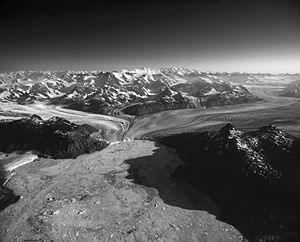Columbia Glacier (Alaska)
| Columbia Glacier | ||
|---|---|---|
|
Columbia Glacier (2004) |
||
| location | Alaska ( USA ) | |
| Mountains | Chugach Mountains | |
| Type | Valley glacier | |
| length | 48 km | |
| surface | 1150 km² | |
| Exposure | southwest | |
| Altitude range | 2700 m - 0 m | |
| width | ⌀ 4.5 km | |
| Coordinates | 61 ° 11 ′ N , 146 ° 57 ′ W | |
|
|
||
| drainage | Columbia Bay ( Prince William Sound ) | |
The Columbia Glacier in Alaska is located 60 km northwest of Valdez and covers an area of 1150 km² with a length of 48 km.
It flows from the Chugach Mountains on the south coast of Alaska into Columbia Bay in Prince William Sound . Its nutrient area lies on the slopes of Mount Einstein and Mount Witherspoon at an altitude of about 2700 m . The tongue of the glacier pushes itself ten kilometers wide into the sea. The bottom is 700 m under water, the height of the ice wall above sea level is between 50 and 80 m. The Columbia Glacier is one of the fastest flowing glaciers in North America at two meters per day.
The glacier has been retreating sharply since 1980, by more than 20 km by 2014, while its thickness decreased by up to 500 m. As a result, it has lost around half of its volume over the past 25 years. In 2011, the glacier's retreat caused it to split into two glaciers, the tongues of which were already 6 km apart in 2014. James Balog recorded the retreat using time lapse as part of his “extreme ice survey”. Based on the different magnetization of rock, which the glacier only abrades from a certain extent and transports into the sea, where it has been deposited in marine sediments over centuries , researchers were able to show that the glacier has not retreated as far for at least 900 years as it has since Beginning of the 2000s.
The cold, nutrient-rich glacier water ensures a high density of plankton in the surrounding sea and thus a large fish population, as a result of which many predators such as z. B. Keep bald eagles , seagulls and seals near the glacier.
The glacier was named by the Harriman-Alaska Expedition in 1899 after Columbia University in New York .
Web links
- Columbia Glacier in the United States Geological Survey's Geographic Names Information System
- Satellite image of the week: White giant in reverse gear , article in Spiegel Online , May 26, 2012 (with interactive graphics )
- Time-lapse shot of the retreat from 2008 to 2012
Individual evidence
- ↑ Columbia Glacier, Alaska with interactive graphics until 2014. Last accessed July 20, 2017.
- ↑ Extreme ice survey. ( Memento of the original from December 11, 2012 in the Internet Archive ) Info: The archive link was inserted automatically and has not yet been checked. Please check the original and archive link according to the instructions and then remove this notice. Last accessed on July 20, 2017.
- ↑ Anders E. Carlson et al. a .: Recent retreat of Columbia Glacier, Alaska: Millennial context . In: Geology . 2017, doi : 10.1130 / G38479.1 ( oregonstate.edu [PDF; 1.5 MB ]).

